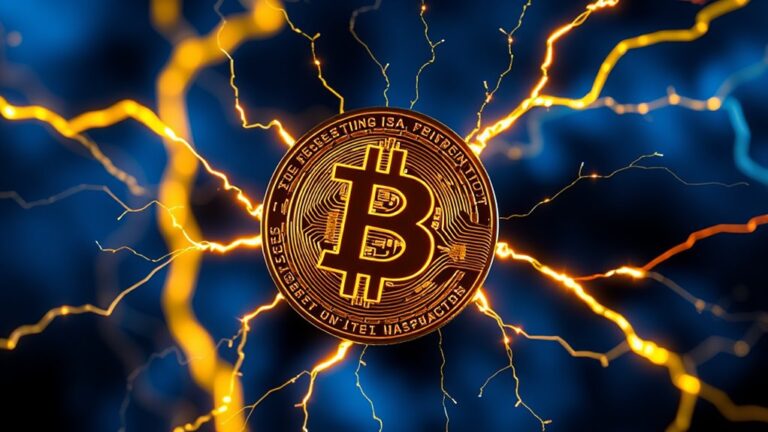
Proof of Work in Bitcoin Explained
Proof of Work (PoW) is a key consensus mechanism used in Bitcoin, requiring miners to use computational power to validate transactions and secure the network. This system deters fraud, particularly double-spending, by having miners solve complex cryptographic puzzles to add new blocks to the blockchain. The process involves significant energy consumption, raising environmental concerns, while also impacting local economies. Understanding the intricacies of PoW reveals both its strengths and challenges within the cryptocurrency landscape.
Table of Contents
Key Takeaways
- Proof of Work (PoW) is a consensus mechanism requiring miners to solve complex puzzles to validate Bitcoin transactions and secure the network.
- Miners compete to solve cryptographic puzzles, broadcasting solutions to other nodes to achieve consensus and prevent double-spending.
- PoW enhances security through significant computational power requirements, making it difficult for any single entity to alter transaction history.
- Bitcoin mining consumes substantial energy, raising environmental concerns, yet over 50% of operations now utilize renewable energy sources.
- Mining impacts local economies by increasing electricity costs and straining resources, potentially affecting GDP and community welfare negatively.
Understanding Proof of Work

Proof of Work (PoW) serves as a fundamental consensus mechanism within the Bitcoin network, requiring participants to expend computational resources to validate transactions and secure the network.
Initially introduced in 1993 to combat denial-of-service attacks, PoW was adapted for digital currencies like Bitcoin. The mechanism involves solving complex cryptographic puzzles using the SHA-256 algorithm, generating hashes that confirm the integrity of blockchain data. This process, known as the mining process, not only validates transactions but also creates new bitcoins, rewarding miners for their efforts.
Although PoW guarantees decentralization and enhances security, it also demands significant energy consumption, raising environmental concerns. The high computational effort required to alter the blockchain acts as a deterrent against malicious attacks.
The Role of Miners in the Network

Miners play an essential role in the Bitcoin network by validating transactions and securing the blockchain. They guarantee the integrity of the network through several key functions:
- Transaction Verification: Miners confirm the validity of transactions to prevent double-spending.
- Block Creation: They compile transactions into blocks, which are then added to the blockchain.
- Network Security: By solving complex puzzles, miners protect the blockchain from alterations and malicious attacks.
Additionally, miners contribute to decentralization by allowing anyone with the right equipment to participate, preventing control by a single entity. They also help manage currency issuance through block rewards and transaction fees, aligning their economic interests with the network’s success. This multifaceted role is crucial for Bitcoin’s functionality and security, as it mirrors the competitive nature of industrial mining operations that emphasizes efficiency and resource management.
How Consensus Is Achieved

Consensus in the Bitcoin network is achieved through a decentralized mechanism that guarantees all participants agree on the state of the blockchain. This consensus prevents issues like double-spending, which can occur without a central authority.
The Proof-of-Work (PoW) system plays an essential role, where miners compete to solve complex mathematical puzzles. When a miner successfully solves a puzzle, they broadcast their solution, and other nodes verify it to maintain trust without needing a central entity.
This process guarantees that all nodes in the distributed network continuously validate transactions. By utilizing computational power as a form of “vote,” PoW helps prevent manipulation and allows for a sustainable method of reaching consensus among participants in the network. Additionally, the peer-to-peer network structure of Bitcoin enhances its resilience against attacks and failures.
Security Features of PoW

The security features of proof of work (PoW) in Bitcoin are essential for maintaining the integrity and resilience of the network.
By requiring substantial computational power, PoW establishes high security standards that deter attacks and guarantee decentralized network integrity.
However, this energy-intensive process raises concerns about environmental impact, prompting discussions on the balance between security and sustainability in blockchain technology. Additionally, the significant carbon footprint associated with mining operations further complicates the discourse on the ecological implications of PoW systems.
High Security Standards
While Bitcoin’s Proof of Work (PoW) system may seem complex, its high security standards are built on several key features that confirm the integrity of transactions and the overall network.
These features include:
- Complex Mathematical Problems: Miners solve intricate puzzles, creating a robust security foundation.
- Decentralized Mining: This structure prevents control by any single entity, enhancing trust across the network.
- Immutable Ledger: Altering past transactions is nearly impossible, as it would require redoing all subsequent work.
Additionally, the mining difficulty adjusts according to the network’s total computational power, ensuring consistent block generation times and maintaining equilibrium in miner profits.
Together, these characteristics create a resilient system that deters attacks and promotes trust among users.
The combination of decentralized validation and significant computational effort confirms that the network remains secure, maintaining the integrity necessary for a reliable digital currency.
Energy Consumption Concerns
How does the energy consumption of Bitcoin mining impact its overall sustainability?
Bitcoin mining consumes approximately 112 terawatt hours of electricity annually, comparable to the energy needs of entire countries like Poland or Ukraine. This high energy demand raises significant environmental concerns, particularly regarding carbon emissions, which reach around 62 metric tons of CO2 annually.
While many mining operations still rely on fossil fuels, there is a growing trend toward utilizing renewable energy sources such as hydro, wind, and solar power. In some regions, up to 73% of Bitcoin’s energy could be carbon-neutral. Assessing energy costs is crucial for understanding the long-term viability of Bitcoin mining.
However, as Bitcoin’s popularity increases, so too does its energy consumption, prompting ongoing discussions about the need for more sustainable mining practices and potential regulations.
Decentralized Network Integrity
Decentralization serves as a cornerstone of Bitcoin’s network integrity, ensuring that no single entity can dominate or manipulate the system. This decentralized approach enhances security through several key features:
- Resistant to Centralization: Mining is distributed, preventing control by one group.
- Tamper-Evident Blockchain: Each block is linked by hashes, making alterations easily detectable.
- 51% Attack Protection: Achieving control over 51% of the network requires immense computational power, deterring malicious attempts.
Through these mechanisms, Bitcoin fosters a secure environment for transactions. Additionally, its role in future global finance highlights how decentralized systems can challenge traditional financial structures.
The independent validation of blocks by miners promotes network consensus, encouraging trust without a central authority.
Energy Consumption Concerns

Energy consumption concerns surrounding Bitcoin are significant due to the extensive electricity required for its operation.
Bitcoin’s annual energy consumption is estimated to be between 91 and 172 terawatt-hours (TWh), comparable to the energy use of small countries like Poland. This high consumption is largely attributed to the Proof of Work (PoW) consensus mechanism, which necessitates solving complex mathematical problems.
Each transaction consumes far more energy than traditional payment systems like Visa or alternative networks using Proof of Stake (PoS). In addition, Bitcoin mining generates around 22 million metric tons of carbon dioxide annually, raising environmental alarms.
Despite these issues, over 50% of Bitcoin mining now utilizes renewable energy sources, indicating a gradual shift toward more sustainable practices.
Economic Implications of Mining

The economic implications of Bitcoin mining extend far beyond the cryptocurrency itself, affecting local communities and broader economic systems.
Mining operations influence electricity demand, which can lead to increased costs for households and businesses, thereby straining local economies.
Key implications include:
- Households in mining areas may see annual electricity bill increases of $88, while small businesses face an average rise of $168.
- Mining activities can contribute to local GDP declines of around 8.2%, as they often crowd out other industries.
- Increased electricity consumption from miners can lead to higher carbon emissions, impacting environmental sustainability.
Historical Development of PoW in Bitcoin

While the concept of Proof-of-Work (PoW) was not originally designed for cryptocurrencies, its historical development laid the foundation for Bitcoin and other blockchain technologies. The idea began in the early 1990s to combat email spam, with Moni Naor and Cynthia Dwork proposing “Pricing via Processing.”
Adam Back’s 1997 creation, Hashcash, further utilized computational effort as a deterrent. In 2004, Hal Finney introduced “reusable Proof-of-Work,” which paved the way for digital cash systems.
Satoshi Nakamoto’s 2008 Bitcoin whitepaper integrated PoW as its consensus mechanism, allowing decentralized transaction validation. This innovation not only addressed the double-spending problem but also incentivized miners worldwide, securing Bitcoin’s foundational role in the domain of digital currencies.
Frequently Asked Questions
How Does Bitcoin’s Pow Differ From Other Consensus Mechanisms?
Bitcoin’s Proof of Work differs from other consensus mechanisms primarily in its energy-intensive validation process, requiring significant computational power, unlike Proof of Stake, which relies on staked assets and is typically more energy-efficient and faster.
Can Individuals Mine Bitcoin Using Regular Computers?
Individuals can attempt to mine Bitcoin using regular computers, but the escalating network difficulty and competition from specialized hardware create significant obstacles. Ultimately, profitability remains elusive, often resulting in minimal returns and potential hardware damage.
What Happens to Mined Bitcoin if It’s Not Claimed?
If mined Bitcoin remains unclaimed, it becomes part of the total supply but is effectively removed from circulation. This scarcity can enhance the value of remaining Bitcoin, affecting market dynamics over time.
Are There Any Rewards for Non-Mining Network Participants?
Non-mining network participants, such as transaction users and full nodes, contribute to Bitcoin’s functionality and security. However, unlike miners, they receive no financial rewards, highlighting the distinct roles within the cryptocurrency ecosystem.
How Are Transaction Fees Determined in Bitcoin Mining?
Transaction fees in Bitcoin mining are determined by transaction size, network demand, and competition among users. Higher fees expedite processing, while tools estimate current rates, reflecting fluctuating market conditions and congestion levels within the network.
Conclusion
To summarize, proof of work serves as the backbone of Bitcoin’s integrity, where miners act as vigilant sentinels, validating transactions and securing the network. This process, akin to a digital treasure hunt, guarantees consensus while posing challenges, such as energy consumption and economic ramifications. As Bitcoin continues to evolve, the balance between its security and environmental impact remains a focal point of discussion, highlighting the need for innovation in the world of cryptocurrency.




